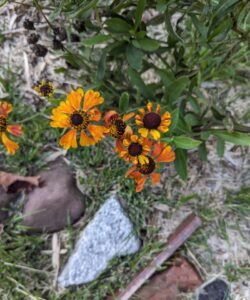 My late summer garden is still waiting for its moment of glory—when the New England asters that have multiplied in droves, will burst into waves of blue, pink and purple glory. In the meantime, my spirits are bolstered by a few large dots of landscape color, including the last of the purple and white coneflowers, the large potted lantana that I bought in desperation last week, and the opulent roses of Sharon. The latter began flowering weeks ago, but even though each bloom lasts only a day, the total flowering period goes on for at least a month.
My late summer garden is still waiting for its moment of glory—when the New England asters that have multiplied in droves, will burst into waves of blue, pink and purple glory. In the meantime, my spirits are bolstered by a few large dots of landscape color, including the last of the purple and white coneflowers, the large potted lantana that I bought in desperation last week, and the opulent roses of Sharon. The latter began flowering weeks ago, but even though each bloom lasts only a day, the total flowering period goes on for at least a month.
The hottest spot by far is occupied by sneezeweed or Helenium autumnale, as it is known to its botanist friends. My sneezeweed clump is about three feet tall and around 18 inches wide. The stiff, somewhat hairy stems are topped by daisy-like flowers with petals that combine all the summer and early fall colors—golden yellow, burnt orange, and red. All of that flashiness surrounds domed brown flower centers that must feel like plump cushions to the bees that land on them.
You have probably seen sneezeweeds, but may not have known their name. From a distance, you might think they were threadleaf coreopsis, based on flower size and general configuration. Judging by color alone, you might suspect a relationship to the flashy gallardia daisies that ornament so many gardens in summer. Taking in those plump flower centers, you would be justified in thinking that you were seeing some kind of small-flowered coneflower or Echinacea.
You would not be far wrong. Helenium, like coreopsis, coneflowers and gallardia daisies, are part of the vast daisy or Compositae family. The Latin name comes from the composite flower configuration, which is frequently, but not always, made up of round centers that contain the miniscule true flowers, surrounded by rays or petals that entrance viewers and may help pollinators find their way to the flowers.
Like its relations coneflowers and coreopsis, Helenium is native to North and South America. This makes its Latin name somewhat confusing. The pundits say that Helenium was named after a Greek plant, “helenion”, which was, in turn, named in honor of that celebrated beauty, Helen of Troy, whose abduction in ancient times was cited as the proximate cause of the Trojan War.
No wars have been fought over helenium, though plant breeders and merchandisers no doubt engage in vigorous competition, especially over Helenium autumnale, the parent species of most of the sneezeweed hybrid varieties currently on a market.
Helenium, like many American native plants, from Echinacea, to prairie grasses, to Solidago or goldenrod, attracted the attention of European plantspeople before it was celebrated here. In the 1930’s, the great German plant breeder, Karl Foerster—1874-1970—developed ‘Moerheim Beauty’, a red-flowered sneezeweed with petals that fade to burnt orange. It is still in commerce today, as is another favorite Foerster plant, the domesticated black-eyed Susan, Rudbeckia fulgida ‘Goldsturm’, that nearly everyone I know has blooming in their garden right now. The Germans and Dutch have continued their sneezeweed-improving ways, but Americans, Brits and others have joined the efforts.
My own sneezeweed is ‘Sahin’s Early Flowerer’, a Dutch introduction that features all the sneezeweed colors in an ever changing array. Each of the one to two inch flowers has a rounded center and wedge-shaped rays, but no two blooms are exactly the same color pattern.
The trademarked Mariachi series of sneezeweeds features the flashy ‘Fuego’, which boasts red petals edged in yellow at the ends and in a ring around the center. Its slightly more demure sibling is Mariachi ‘Sombrero’, with golden yellow petals.
With so many varieties available, all gardeners really have to do is pick favored colors or color combinations, with some thought to early or later season bloom. The lanky stems and medium green leaves, which are opposed on those stems, are nothing to write home about, so planting lower-growing annuals or perennials in front of sneezeweeds is a good garden practice.
If you have a bit of sunny space, you have room for sneezeweeds. They like consistent moisture in dry weather, but are not liked by deer and other varmints of suburbia. They also last well in cut flower arrangements–if you have the heart to take them out of the garden at a time when the garden is most likely suffering from end-of-summer doldrums.
Sneezeweed acquired its common name not from allergy-inducing qualities, but because plant parts used to be dried and ground into snuff, which frequently produces sneezes from habitual users. I am quite sure that no one grows the plants for snuff any more. If you want to use them to beautify your garden, try Digging Dog Nursery, 31101 Middle Ridge Road , Albion, CA 95410; Tel. (707) 937-1130; www.diggingdog.com. Print catalog available.
